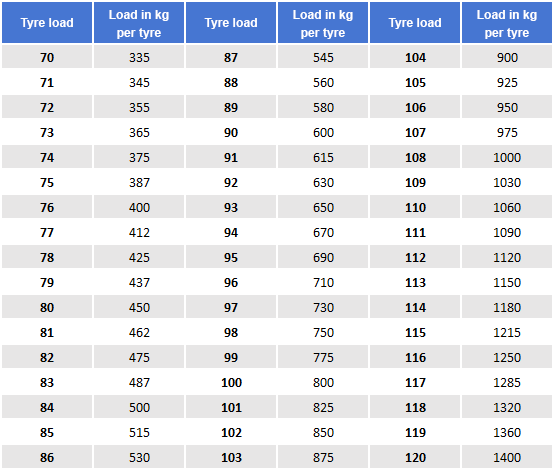
Quick Answer: A tyre’s load rating, also known as the load index, indicates the maximum weight a tyre can safely support when properly inflated. It is a numerical code found on the tyre’s sidewall, often accompanied by a speed rating. The load rating helps ensure that tyres are suitable for the vehicle’s weight and its typical load, including passengers and cargo.
In this blog, we’ll explain everything there is to know about load ratings – so you can confidently choose your next tyres based on your exact needs.
What is a Load Rating?
- It’s a numerical code displayed on the sidewall of your tyre, typically ranging from 62 to 126 for passenger vehicles and higher for trucks and SUVs.
- A higher load rating signifies a greater weight capacity. For instance, a tyre with a load rating of 91 can support 615 kg, while a load rating of 99 corresponds to a maximum weight of 775 kg.
- The tyre load rating and tyre speed rating are related as they both provide critical information about a tyre’s capabilities, indicating the maximum weight it can support and the maximum speed it can sustain safely, respectively, ensuring the tyre is suitable for the vehicle’s performance requirements.
Why is Load Rating Important?
Using tyres with the correct load carrying capacity for your vehicle is essential for performance and safety.
Tyres with an insufficient load rating can:
- Overheat due to excessive weight, leading to blowouts.
- Wear out faster.
- Negatively impact handling and braking performance.
How to Find Your Vehicle’s Load Rating Requirements?
- You will find load index and speed rating in your vehicle’s owner’s manual.
- There’s usually a sticker on the driver’s side door jamb that specifies the recommended tyre size and load rating.
- A tyre’s load index is also printed on the sidewall of the tyre – but it’s important to double check that the current tyre load capacity corresponds to manufacturer recommendations.
Additional Considerations:
- Speed Rating: Load ratings work hand-in-hand with speed ratings. A tyre with a high load rating might have a lower speed rating, and vice versa. Ensure both the load rating and speed rating meet your vehicle’s specifications.
- Driving Conditions: If you frequently carry heavy loads or tow a trailer, consider tyres with a higher load rating to ensure adequate support.
By understanding and following the recommended load rating for your tyres, you contribute to:
- Safety: Reduced risk of tyre failures and accidents.
- Performance: Optimal handling, braking, and fuel efficiency.
- Tyre Lifespan: Extended tyre life due to proper weight distribution.
Remember: When replacing your tyres, always consult a qualified professional or your vehicle’s manual to ensure you choose tyres with the correct load rating and speed rating for your specific vehicle and driving needs.
Tyre Load Rating Chart
Don’t worry if you’re not certain what load index number you require for your vehicle. All tyre workshops will have access to a tyre load index chart or load index table that gives all the necessary information about which new tyres will work with your vehicle.
These tables consider the total load capacity of a vehicle too. Adding people and luggage to a vehicle can significantly increase the overall weight – so it’s important that they make sure they’re not offering a tyre with a lower load index than is actually required

Want to make sure your new tyres carry the correct tyre load ratings?
While it’s fairly easy to consult a load index chart – most people prefer to rely on a trustworthy tyre retailer to make sure they’re buying the right tyres.
This is where Auto Hero can help. Our network of Australian tyre partners is made up of highly-rated and trusted retailers who are motivated and hungry for your business. This means they’re always on hand to offer advice and great prices on tyres that are suitable for your vehicle.
Written By
Matt Banks
Matt is the founder of Autohero.com.au and has been hooked on cars and repairs ever since childhood.
A veteran in automotive since leaving school, Matt has completed his trade as a panel beater and is across all things with wheels.
His first car was a 1967 FORD XR Wagon followed by a string of collectable Holden’s.
Have a question for Matt? Leave a comment below.
